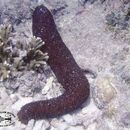en
names in breadcrumbs


Scambicornus affinis Ho, 1982 (parasitic: endoparasitic)
Scambicornus pectinis Ho & I.H. Kim, 1990 (parasitic: ectoparasitic)
Scambicornus pectinis Ho & I.H. Kim, 1990 (parasitic: endoparasitic)
Scambicornus idoneus (Humes & Cressey, 1961) (parasitic: endoparasitic)
In Panama this species has been collected from the Perlas Archipelago (USNM E 22615), Gulf of Panama, eatern Pacific.
Deichmann, E. (1948). The Holothurian fauna of South Africa. Annals of the Natal Museum 11 (2): 325-376.
Heding, S. (1934). On some Holothurians from Hong Kong. Hong Kong Nat. Suppl. 3: pp. 15-25.
Heding, S. G. (1939). The Holothurians collected during the cruises of the M/S Monsunen in the tropical Pacific in 1934. Vidensk. Medd. naturh. Foren. Kjob 102: pp. 213-222.
Ludwig, H. (1886). Die von G. Chierchia auf der Fahrt der Kgl. Ital. Corvette Vittor Pisani gesammelten Holothurien. Zool. JB. ii: pp. 1-36.
Sluiter, C. P. (1887). Die Evertebraten aus der Sammlung des Königlichen Naturwissenschaftlicher Vereins in Niederländisch Indien in Batavia. Die Echinodermen. 1. Holothuroidea. Natuurkundig Tijdschrift voor Nederlandsch Indië. 47, 8e Serie. 8: 181-220, 2 pls.
Sluiter, C. P. (1901). Die Holothurien der Siboga-Expedition. Monogr. xliv. Uitkomst. H. M. Siboga...uitgegeven Max Weber. Die Holothurien der Siboga-Expedition. Monogr. xliv. Uitkomst. H. M. 142 pp.
World Register of Marine Species
LSID urn:lsid:marinespecies.org:taxname:210881Halodeima dicorona Heding, 1934
Holothuria gelatinosa Heding, 1939
Holothuria homoea Clark, 1938
Holothuria infesta Sluiter, 1901
Holothuria lagoena Haacke, 1880
Holothuria lamperti Ludwig, 1887
Holothuria oxurropa Sluiter, 1887
Holothuria vagabunda Selenka, 1867
Stichopus (Gymnochirota) leucospilota Brandt, 1835
Holothuria leucospilota, commonly known as the black sea cucumber or black tarzan, is a species of marine invertebrate in the family Holothuriidae. It is placed in the subgenus Mertensiothuria making its full scientific name Holothuria (Mertensiothuria) leucospilota. It is the type species of the subgenus[2] and is found on the seabed in shallow water in the Indo-Pacific.
Holothuria leucospilota is a medium-sized sea cucumber reaching a length of up to 40 centimetres (16 in) when relaxed but it can stretch to about a metre (yard) when extended. It is roughly cylindrical, tapering towards the posterior end. At the anterior end, there are twenty oral tentacles with branched tips. These surround the mouth which is on the under side of the body. The animal is soft and pliable and is covered with fleshy papillae. The usual colour is charcoal grey or reddish-black with pale grey tube feet on the underside[3][4] but off the African coast it is described as being bright or dark brown with white patches which are larger towards the posterior end.[2]
Holothuria leucospilota is found in shallow water along the east coast of Africa and in much of the Indo-Pacific region.[2] It is a common species on the north east coast of Australia where it is found on reefs and rocky coasts, often partly concealed under a boulder.[3]
A study done near Singapore found that Holothuria leucospilota was more common near boulders, corals and seaweed clumps than it was on the open seabed. It found that this species is relatively tolerant of changes in salinity and temperature and continued to thrive in the laboratory when these parameters were changed. Under the same conditions, the Japanese sea cucumber (Apostichopus japonicus) shrank in size, eviscerated, and died within three days. In Singapore, Apostichopus japonicus is consumed as food and is becoming increasingly rare as a result of overexploitation.
Holothuria leucospilota is a scavenger and when feeding it usually has its posterior end anchored underneath a rock or in a crevice so that it can contract back out of sight if disturbed. It feeds by using its tentacles to shovel organic debris lying on the seabed into its mouth. In the process it swallows a significant quantity of sand, which passes through the gut.[4]
If threatened, Holothuria leucospilota can emit a mass of fine sticky Cuvierian tubules from its anus which ensnare the potential predator allowing the sea cucumber to escape.[5] It can regenerate these tubules in fifteen to eighteen days.[5]
The worm pearlfish (Encheliophis vermicularis) is a parasite of this species and each parasitised H. leucospilota will host a male and female pair of the fish which live inside its body.[6]
Holothuria leucospilota, commonly known as the black sea cucumber or black tarzan, is a species of marine invertebrate in the family Holothuriidae. It is placed in the subgenus Mertensiothuria making its full scientific name Holothuria (Mertensiothuria) leucospilota. It is the type species of the subgenus and is found on the seabed in shallow water in the Indo-Pacific.